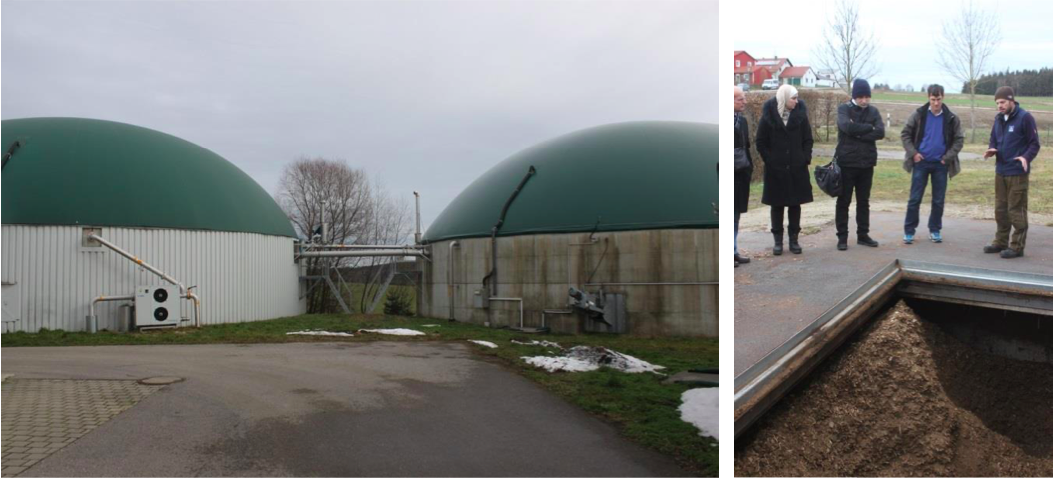Germany
2012
- Type : Project
- Size : Local community
- Area : Residential
Environmental benefit
Heat supply from a Biogas Plant in Vatersdorf
Share
Germany
2012
- Type : Project
- Size : Local community
- Area : Residential
Environmental benefit
Discover this use case online

The farmer and agricultural engineer Ulrich Bader installed in 2006 a biogas plant in Vatersdorf, a small village in southern Germany. In its initial phase, the main objective of the biogas plant was to only maximize power production due to the favourable conditions in Germany for renewable electricity generation (feed-in tariffs). Besides the heat supply for heating the digesters, for his farmer’s house and for drying woodchips, the heat was released without use. This was typical for most biogas plants in Germany. Due to this inefficient overall energy use, Ulrich Bader decided to install a small district heating network in order to supply the households of Vatersdorf. In 2012, the heating grid was realized by Ulrich Bader, who did most of the planning and construction himself. He was supported by the heat pipe manufacturer Rehau.
Some biogas plant operators who have also a heat grid only sell as much heat as they have available. This means that the heat supply is not guaranteed, so that the consumers still have to maintain their own heating system in the house as back-up. Ulrich Bader, however, decided to be fully responsible for the heat supply and to guarantee it throughout the year and at any low ambient temperatures. Thus, the households practically do not need any other heating device in their household, except the connection point to the heating grid. In such a system, he needs further heat sources to complement the heat supply of the biogas plant. This is done by two woodchip boilers which are in use in the cold season. For peak load demand he furthermore has a fossil oil boiler, since other solutions would not have been economically feasible. Nevertheless, the operation of this peak load boiler is very limited.
The available heat from the biogas plant in summer is still too much for the hot water demand of the households. In order not to waste this heat, Ulrich Bader has invested in a feed-and-turn dryer, which can dry woodchips (for the small heating grid of Ulrich Bader as well as for external woodchip traders) and cereals. The woodchip drying can be considered as energy storage, since it increases the energy value of the wood chips. In doing so, all the heat of the biogas plant is used and the additional demand is covered by the woodchip and peak load boilers.
More info
 R-ACES has received funding from the European Union’s Horizon 2020 research and innovation programme under grant agreement N° 892429
R-ACES has received funding from the European Union’s Horizon 2020 research and innovation programme under grant agreement N° 892429
The farmer and agricultural engineer Ulrich Bader installed in 2006 a biogas plant in Vatersdorf, a small village in southern Germany. In its initial phase, the main objective of the biogas plant was to only maximize power production due to the favourable conditions in Germany for renewable electricity generation (feed-in tariffs). Besides the heat supply for heating the digesters, for his farmer’s house and for drying woodchips, the heat was released without use. This was typical for most biogas plants in Germany. Due to this inefficient overall energy use, Ulrich Bader decided to install a small district heating network in order to supply the households of Vatersdorf. In 2012, the heating grid was realized by Ulrich Bader, who did most of the planning and construction himself. He was supported by the heat pipe manufacturer Rehau.
Some biogas plant operators who have also a heat grid only sell as much heat as they have available. This means that the heat supply is not guaranteed, so that the consumers still have to maintain their own heating system in the house as back-up. Ulrich Bader, however, decided to be fully responsible for the heat supply and to guarantee it throughout the year and at any low ambient temperatures. Thus, the households practically do not need any other heating device in their household, except the connection point to the heating grid. In such a system, he needs further heat sources to complement the heat supply of the biogas plant. This is done by two woodchip boilers which are in use in the cold season. For peak load demand he furthermore has a fossil oil boiler, since other solutions would not have been economically feasible. Nevertheless, the operation of this peak load boiler is very limited.
The available heat from the biogas plant in summer is still too much for the hot water demand of the households. In order not to waste this heat, Ulrich Bader has invested in a feed-and-turn dryer, which can dry woodchips (for the small heating grid of Ulrich Bader as well as for external woodchip traders) and cereals. The woodchip drying can be considered as energy storage, since it increases the energy value of the wood chips. In doing so, all the heat of the biogas plant is used and the additional demand is covered by the woodchip and peak load boilers.
